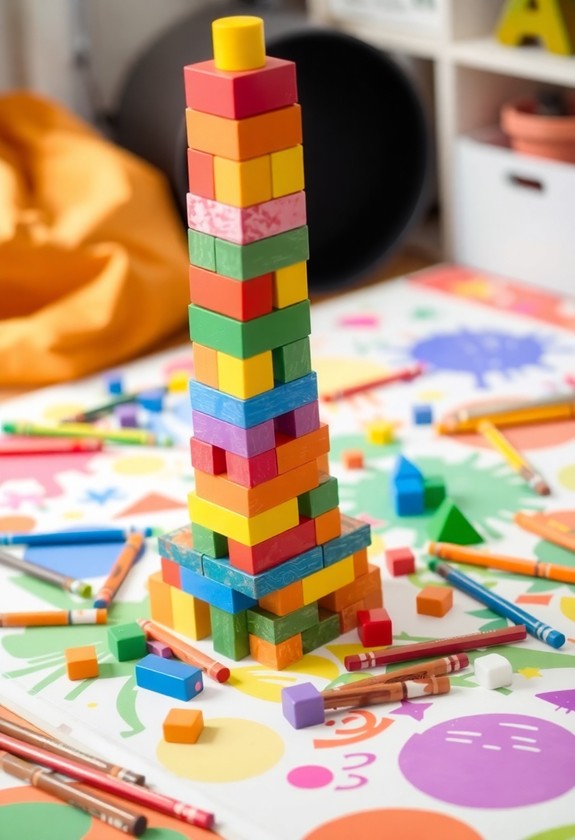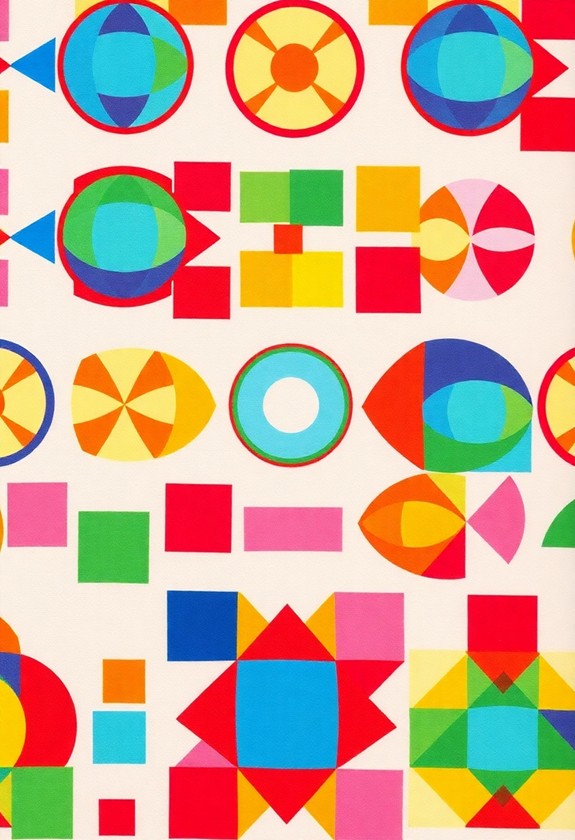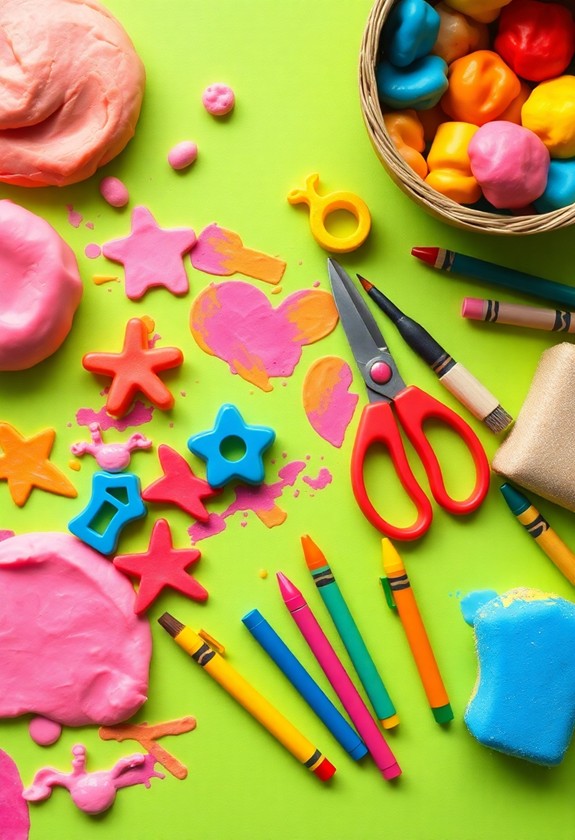Art is a problem-solving powerhouse for your toddler! It boosts spatial skills through drawing, sparks curiosity with color mixing, and sharpens shape recognition via collages. Tactile exploration builds sensory awareness, as sculpting teaches adaptability. Unexpected results? No problem! Your little one learns to adjust on the fly. Collaborative projects hone negotiation skills, and tool selection improves critical thinking. Plus, self-expression through creative choices builds confidence. And don’t forget – messy play is A-okay! These fun, hands-on activities develop essential cognitive abilities that’ll serve your child well beyond the art table. Ready to release your toddler’s inner problem-solver?
Creative Highlights
- Art projects encourage trial and error, teaching toddlers to learn from mistakes and adapt to challenges.
- Collaborative art activities develop social problem-solving skills through teamwork and negotiation.
- Exploring various art tools and materials enhances critical thinking and decision-making abilities.
- Creating art improves spatial reasoning, helping toddlers understand shapes, sizes, and relationships between objects.
- Tactile and sensory exploration in art develops cognitive skills and promotes creative problem-solving approaches.
Spatial Reasoning Through Drawing
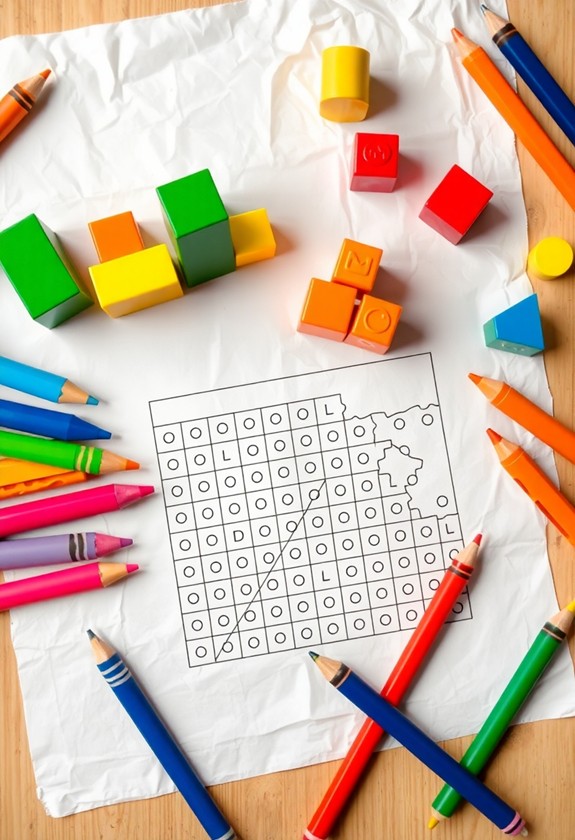
Through the process of drawing, toddlers develop vital spatial reasoning skills. It’s amazing! When your little one grabs a crayon and starts scribbling, they’re actually learning about shapes, sizes, and how objects relate to each other in space. Wow! Bright colors and patterns in their artwork stimulate cognitive development and bring joy to their creative process. Incorporating interactive elements like glow-in-the-dark stickers can further inspire hands-on creativity.
You can boost this skill by:
- Encouraging free drawing
- Asking them to describe their creations
- Playing shape-matching games
But wait, there’s more! Drawing additionally helps with:
- Hand-eye coordination
- Fine motor skills
- Visual perception
Color Mixing Experiments
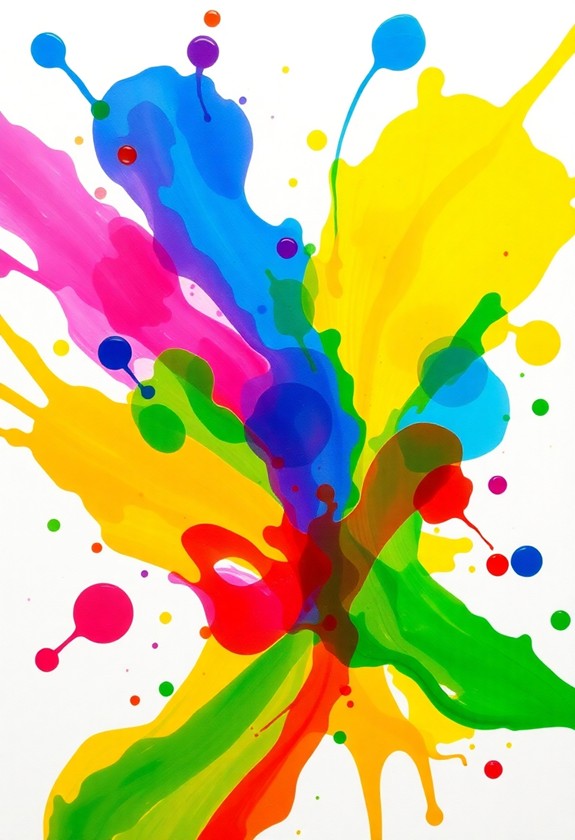
Curiosity drives toddlers to explore the world of colors through mixing experiments. It’s like magic! Watch their eyes light up as they find out that red and yellow make orange, or blue and yellow create green. These hands-on experiences are more than just fun – they’re building problem-solving skills! Triangle-shaped crayons and markers can improve grip during these experiments, aiding in the development of fine motor skills essential for artistic expression.
Here’s how you can set up a color-mixing station:
- Gather primary colors (red, blue, yellow)
- Provide clear containers
- Add water or white paint
- Let the mixing begin!
As your little one experiments, ask questions:
- What do you think will happen if…?
- Can you make purple?
- How many colors can you create?
These colorful adventures teach cause and effect, prediction, and creative thinking. Plus, they’re a great way to introduce basic scientific concepts. So, get ready for a rainbow of learning opportunities!
Tactile Exploration With Textures
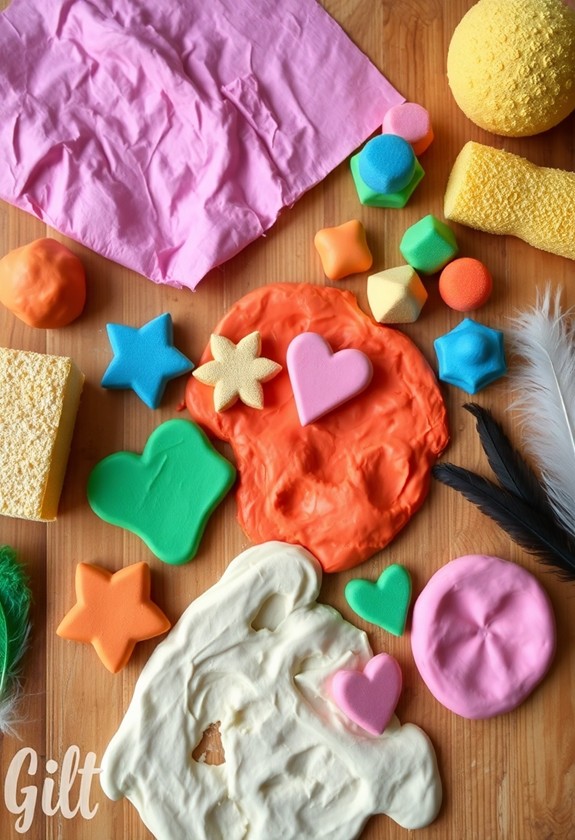
Beyond color mixing, toddlers can develop problem-solving skills through tactile investigation of textures. Enhancing fine motor skills and hand-eye coordination, texture investigation is a fantastic way to boost creativity and self-expression in children. Let’s plunge into this exciting world of touch and feel! You can create a texture board with various materials for your little one to examine. Watch as they figure out:
- How to match similar textures
- Which textures feel rough or smooth
- How to sort objects by their texture
- What happens when they combine different textures
It’s amazing to see their little minds at work! Encourage them to describe what they’re feeling – is it bumpy, soft, or scratchy? This helps build vocabulary too. Try hiding objects under different textured fabrics and see if they can guess what’s underneath. It’s like a fun, sensory treasure hunt! By investigating textures, your toddler’s problem-solving skills will skyrocket, and they’ll have a blast doing it!
Shape Recognition in Collages
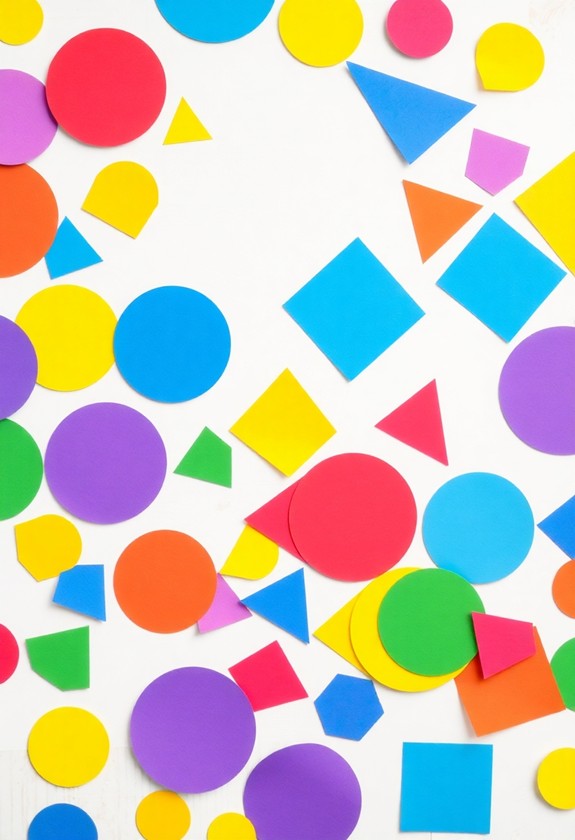
Shape-recognition activities using collages offer a fantastic way to improve your toddler’s problem-solving skills. It’s a blast! You’ll watch your little one’s mind work as they piece together different shapes to create a masterpiece. Here’s how to get started:
- Gather colorful paper shapes (circles, squares, triangles)
- Let your toddler arrange them on a blank sheet
- Encourage them to identify shapes and colors
As they play, they’re actually solving mini-puzzles! They’ll figure out how shapes fit together, which is a building block for more complex problem-solving later on. Plus, it’s a great chance to teach new words. “Look at that red triangle!” or “Can you find a blue circle?”
Trial and Error in Sculpture
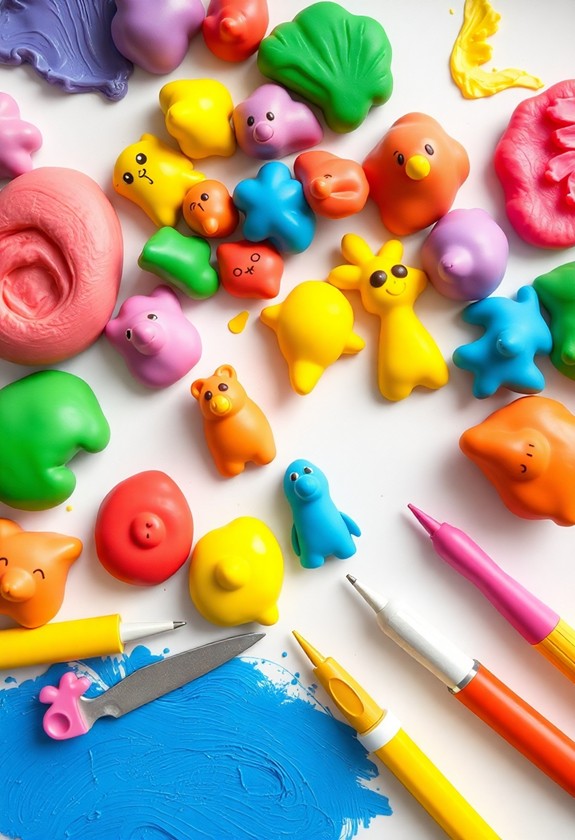
Sculpture offers another exciting avenue for toddlers to develop problem-solving skills through art. It’s a hands-on, 3D experience that’ll challenge their little minds! When you give your tot some clay or play-dough, you’re opening up a world of possibilities. They’ll learn through trial and error, figuring out:
- How much pressure to apply
- Which shapes stick together
- How to balance different parts
- What tools work best for different effects
Watch as they squish, mold, and create! They might get frustrated at first, but don’t worry. That’s all part of the learning process. Encourage them to keep trying, and soon you’ll see their problem-solving skills in action. They’ll experiment with different techniques, learning what works and what doesn’t. It’s like a mini science experiment, but way more fun and messy!
Planning and Executing Art Projects
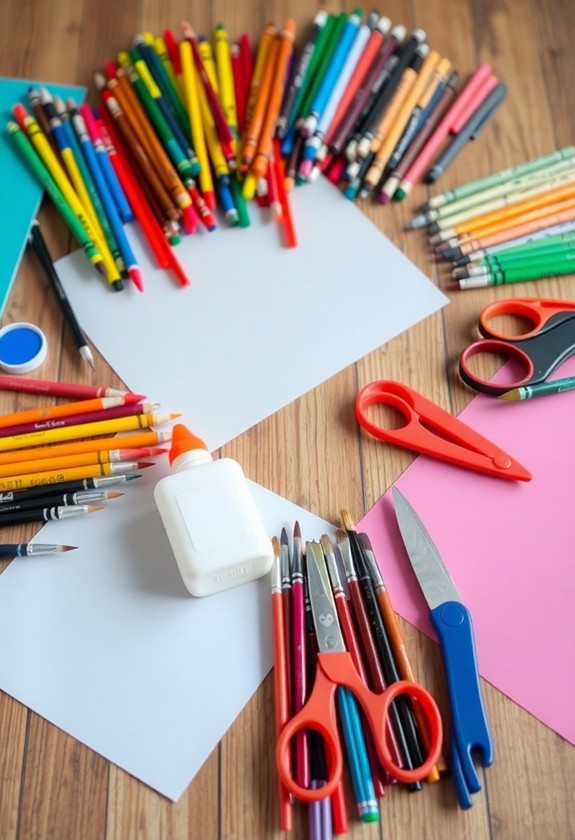
Budding Picassos need more than just creativity; they need a plan! When your little artist tackles a project, encourage them to think it through first. Here’s how:
- Brainstorm ideas: Ask, “What do you want to make?”
- Gather materials: Help them collect everything they’ll need.
- Sketch it out: Even a scribble can be a roadmap!
Now, it’s time to execute! Let your toddler take the lead, but be there to assist. They might hit a snag, but that’s okay! Problem-solving is part of the process. Maybe the glue won’t stick, or the paint’s too runny. Encourage them to find solutions. Can they use tape instead? Add more water to the paint?
Adapting to Unexpected Results
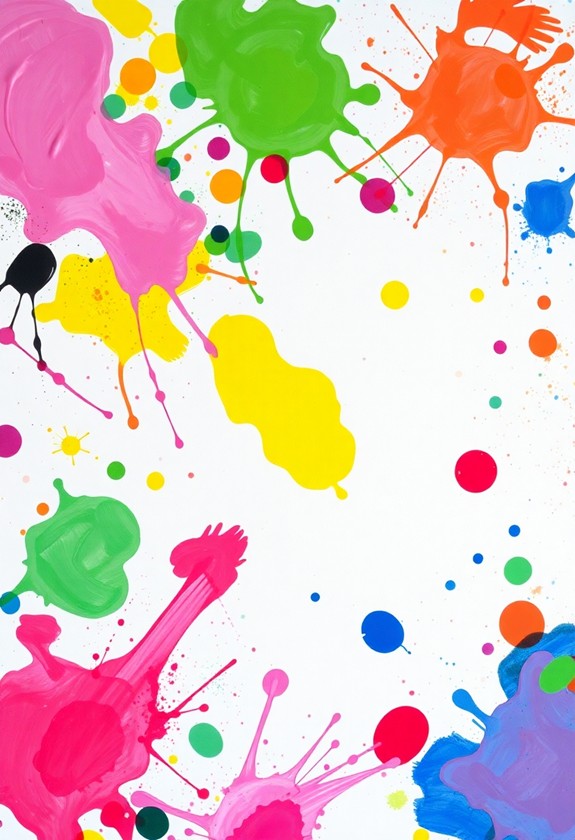
Even though art projects rarely go exactly as planned, that’s part of their beauty and value for toddlers. When unexpected results occur, your little one learns to adapt and problem-solve on the fly. It’s exciting to watch them grow!
Here’s how adapting to unexpected results helps toddlers:
- Flexibility: They learn to roll with the punches and adjust their vision.
- Creativity: Unexpected outcomes spark new ideas and directions!
- Emotional regulation: They practice staying calm when things don’t go as planned.
- Resilience: Overcoming small setbacks builds confidence for bigger challenges.
Encourage your toddler to welcome the unexpected in their art. Say things like, “Wow! That’s different from what we planned. What can we do with it?” or “Look at that happy accident!” This positive approach turns surprises into opportunities for growth and fun!
Collaborative Art and Negotiation
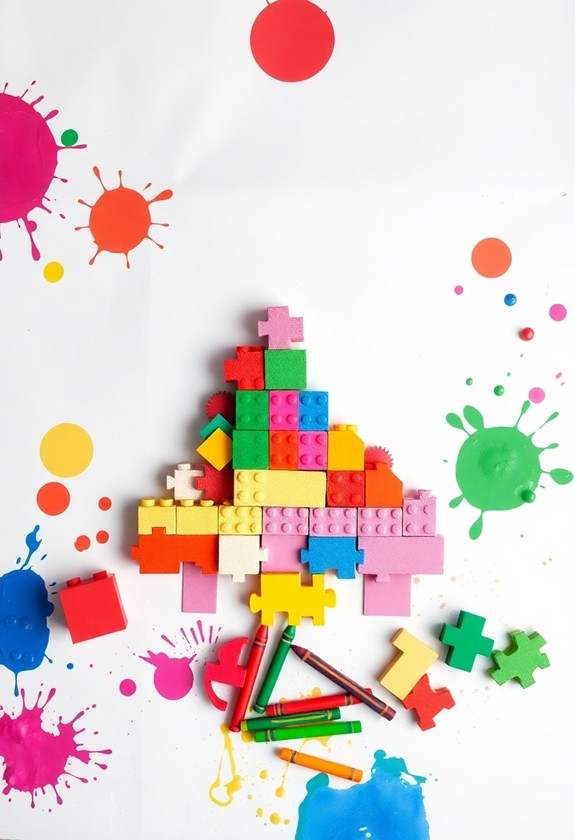
Collaborative art projects offer toddlers a whole new dimension of learning and growth. When your little one works with others, they’re not just making art – they’re building social skills! Watch as they learn to share materials, take turns, and communicate their ideas. It’s like a mini-masterclass in negotiation!
Here’s what you’ll see:
- Toddlers figuring out how to divvy up supplies
- Kids learning to compromise on color choices
- Little artists finding creative ways to combine ideas
And the best part? They’re having a blast during doing it! As they work together, they’re developing empathy, patience, and teamwork skills. It’s like they’re painting their way to better problem-solving abilities! So, grab some art supplies and set up a group project. You’ll be amazed at how your toddler’s negotiation skills will bloom like a beautiful flower garden!
Tool Selection for Different Tasks
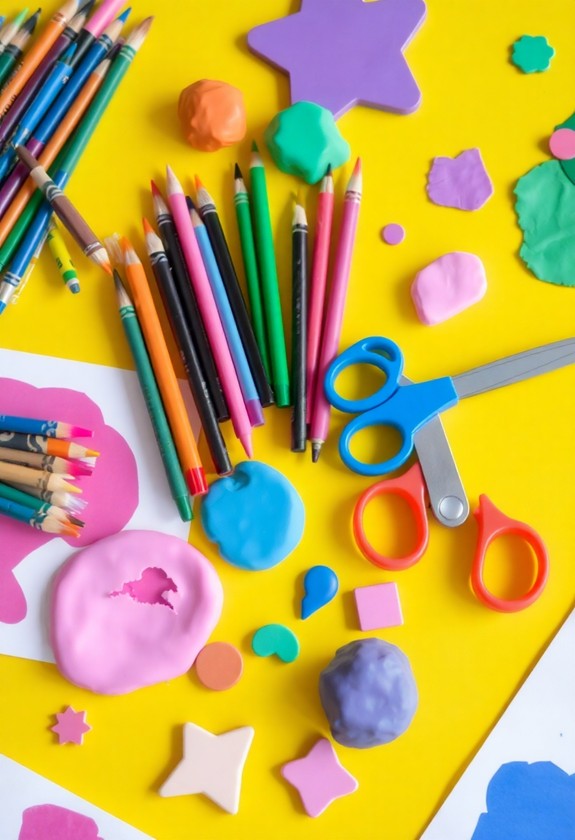
Selecting the right tools for different artistic tasks is an essential skill that toddlers can develop through art projects. It’s amazing how quickly they learn to match tools with tasks! You’ll be thrilled to see your little one’s problem-solving skills grow as they experiment with various art supplies.
Here’s how toddlers learn to choose tools:
- Exploration: They’ll touch, feel, and test different materials
- Trial and error: They’ll find out what works best for each task
- Observation: They’ll watch you and mimic your tool choices
- Practice: They’ll refine their selections over time
Encourage your toddler to try different tools for the same task. For example, painting with brushes, sponges, or even their fingers! This builds flexibility and creativity. Remember, messy play is learning play!
Self-Expression Through Creative Choices
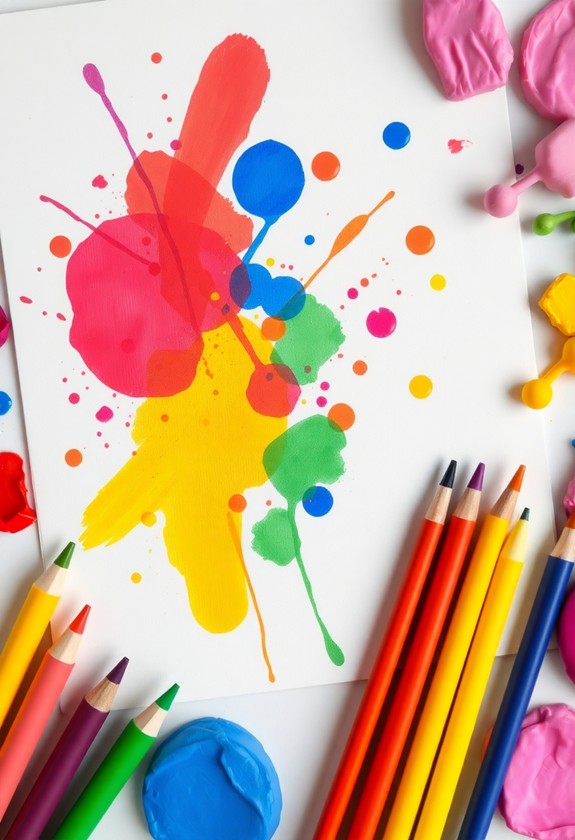
As toddlers gain confidence in their artistic abilities, they naturally begin to express themselves through creative choices. You’ll see them pick their favorite colors, shapes, and textures with gusto! This self-expression is a big deal for problem-solving skills.
When little ones make creative decisions, they’re flexing their mental muscles. They’ll:
- Choose between different materials
- Decide on color combinations
- Figure out how to represent their ideas
These choices help them learn to think independently and solve problems creatively. And boy, does it boost their confidence! As they see their unique creations come to life, they’ll feel a sense of pride and accomplishment. This “I can do it!” attitude carries over into other areas of life, making them more likely to tackle new challenges head-on. So, let your mini Picassos go wild with their artistic choices!
Curious Little Questions
At What Age Should Parents Start Introducing Art Activities to Toddlers?
You can start introducing art activities to your toddler as early as 12 months old! It’s never too early to let their creativity bloom. At this age, they’re ready for simple activities like finger painting or scribbling with crayons. As they grow, you can introduce more complex art projects. Remember, it’s all about exploration and fun! Don’t worry about the mess – that’s part of the creative process. Let your little Picasso release their imagination and watch their skills blossom!
How Can Art Activities Be Adapted for Toddlers With Special Needs?
You might think adapting art for special needs toddlers is impossible, but it’s actually super easy! Here are some fun ideas:
- Use chunky, easy-to-grip crayons or brushes
- Try finger painting for sensory exploration
- Create textured art with materials like sand or foam
- Use adaptive tools like palm-held brushes or scissors
- Break activities into smaller steps
- Offer verbal and visual cues
Are There Any Potential Risks or Safety Concerns With Toddler Art Projects?
You bet there are safety concerns with toddler art projects! But don’t worry, you can easily prevent them. Watch out for:
- Choking hazards: Keep small items out of reach!
- Toxic materials: Use non-toxic, washable supplies only.
- Mess: Cover surfaces and dress kids in old clothes.
- Sharp objects: Supervise scissor use closely.
What Are the Best Art Materials for Toddlers in Terms of Non-Toxicity?
You’ll love these safe art materials for your little Picasso! Non-toxic options are the way to go. Look for:
- Washable markers and crayons
- Finger paints made from food-grade ingredients
- Playdough without harmful additives
- Water-based, non-toxic glue
These materials are a stroke of genius! They’re safe if accidentally ingested and easy to clean up. But wait, there’s more! Many brands now offer eco-friendly options too. So, let your toddler’s creativity run wild without worrying about harmful chemicals. It’s time to make some masterpieces!
How Can Parents Encourage Reluctant Toddlers to Participate in Art Activities?
Hey there, enthusiastic parent! Got a reluctant little artist? Don’t worry! Here are some fun tricks to get your toddler excited about art:
- Make it messy! Let them squish paint with their hands or feet.
- Turn it into a game! Hide toys in playdough or draw silly faces together.
- Go big! Use large paper on the floor for full-body painting.
- Investigate textures! Try sponges, feathers, or even vegetables as paintbrushes.
- Be their cheerleader! Praise their efforts and display their masterpieces proudly.

